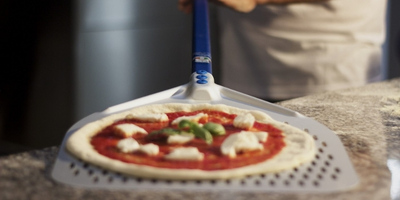The pizza peel has always been one of the symbolic tools which everyone’s imagination associates with pizza chefs. With time, the pizza peel has become the extension of the pizza chef’s arm, undergoing a real evolution: from the manual spreading of the disc of dough on stone at the time of the Roman Empire, passing through the first wooden peels, up until today when the pizza maker can choose from thousands of combinations.
Gi.Metal wants to give you a list of steadfast points of reference that you can start from to choose the next pizza peel you buy. Aware of the fact that the pizza chef has to make hundreds of pizzas nonstop every day while always maintaining a high standard, he or she can’t waste time or get too worn out. Therefore, the pizza peels must be handy, ergonomic and capable of smoothly sliding off the pizza into the oven.
“Through the years we’ve listened to pizza chefs, whose needs showed us the path to follow to make the hundreds of variants that we propose today,” said Marco D’Annibale of GiMetal. “It’s an immense challenge but recompensed by the trust bestowed on us daily. This drives us on to want to keep improving!”
- The Material: Everything is based on the choice of the material. Metal’s anodized aluminum heads are lightweight and flexible with a spatula effect, making it easier to hold onto the pizza. Their strength and durability are guaranteed by the very structure of the peel, and they weigh less than alternative steel or wooden instruments—materials which by now are less and less used.
- Perforated or Solid?: The pizza peels can be perforated or solid. The perforated pizza peel, an innovation thatMetal introduced at the start of the 1990s, has the advantage of allowing the dough to slide easily on the surface, but also let any excess flour fall through. This way, the bottom of the pizza in contact with the oven doesn’t burn, also keeping excess flour deposited on the cooking surface from burning, which generates smoke and makes it necessary to clean the surface more often.

- The Shape: When you buy a pizza peel, the shape and size also matter. The shape can be either rectangular or round. The rectangular pizza peel has a larger contact surface with the dough, making it easy to load. Meanwhile, the round peel allows you to fit the pizzas up close to those already in the oven, since the lack of corners makes them easier to move around when the oven is “crowded.” On the other hand, there is a more limited point of contact while loading, which requires training before becoming familiar with them.

- The Sizes: The chosen sizes of the pizza peel head and lengths of the handle make them practical and ergonomicduring work. Normally the former is chosen based on the size of the pizza you are making, while the length of the handle depends on the depth of the oven: If the handle is too short, you would be excessively exposed to the heat of the oven, whereas if it is too long, it would be hard to maneuver in the restricted working spaces. Gi.Metal boasts of a wide range of sizes for all your needs, as well as innovations, such as the sliding insulation on the handle of the small peels, which perfectly protects your hands from the heat.
Discover more about Gi.Metal pizza tools by visiting the official e-shop and up your pizza game!
Gi.Metal and its team will be waiting for you at the Pizza Expo in Las Vegas, March 22-24, at booth #1585 to help you choose your pizza tools. Check out more details about the event on their Facebook page.
















